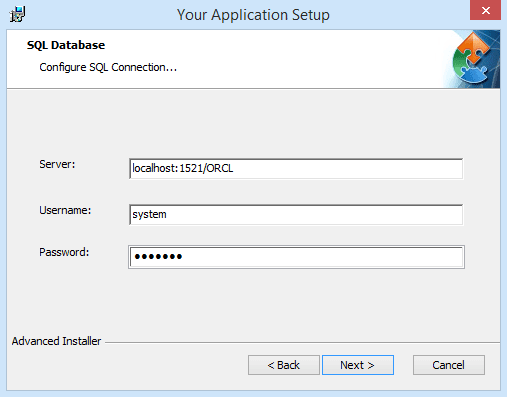Configure Oracle Database Connection
The following article uses options that are available starting with the Enterprise edition and project type.
This tutorial makes use of the preset SQLConnectionDlg dialog, and all the settings will be collected and sent to the installer throughout the installation process. Public properties will be used to accomplish this.
2. Add SQL connection dialog
![]() Go to
Dialogs Page and select
FolderDlg dialog. Select “Add Dialog” toolbar option or
“Add Dialog...” context menu option.
Go to
Dialogs Page and select
FolderDlg dialog. Select “Add Dialog” toolbar option or
“Add Dialog...” context menu option.
The Add Dialog dialog will appear. Select SQLConnectionDlg from the list and press "OK". The new dialog will be added in the chain after the FolderDlg dialog.
In the SQLConnectionDlg dialog select the "ODBC Resource", "Port", "Database" static text controls and from the Properties pane located in the right side, set the Visible attribute to False.
For the edit box controls associated with "ODBC Resource", "Port", "Database" you should follow the same procedure.
3. Create the SQL connection
![]() Navigate to SQL Databases Page, Database server and select “New SQL Connection ->
Predefined SQL Connection” option from the toolbar or context menu.
Navigate to SQL Databases Page, Database server and select “New SQL Connection ->
Predefined SQL Connection” option from the toolbar or context menu.
This will change the installation type to "Per-machine only".
Rename the connection to something that makes sense to you. Write the following settings in the "SQL Connection" properties window on the right side:
| Parameter name | Value |
|---|---|
| Connection Type | Oracle SQL Server |
| Connection Mode | ODBC Driver |
| ODBC Driver | Microsoft ODBC for Oracle |
| Server | [SERVER_PROP] |
| Port | not required |
| Username | [USERNAME_PROP] |
| Use a property to set password | [PASSWORD_PROP] |
| Database | not required |
We won't utilize a property to specify the "ODBC Driver" parameter because we'll be using this connection with Oracle Database Server, therefore we'll have to hard-code it instead.

![]() Add all the
necessary resources like files and folders to the project, build and run it.
Add all the
necessary resources like files and folders to the project, build and run it.
4. Test the installation package
We strongly recommend you to test if the package is correctly connecting to SQL Server before distributing it to your users.
The Test SQL Connection How To article shows the
steps needed to take in order to test your SQL connection.
After running the installation package, browse to the "SQL Database" window and enter the following information:
- Server
- The name of the SQL Server. The supported format is ServerName:PORT/SID. If the server is hosted on the local machine use localhost:1521/ORCL. By default, Oracle Database Server comes with the Listener configured for port 1521 and with the instance ORCL.
- Username
- This is the username which the connection will be established with. This user must have connection rights to the SQL Server. By default, for an Oracle database all the users are disabled except the system users. In this tutorial we will use the system user.
- Password
- The password associated with the user. This password is set during the SQL Server installation.

.
